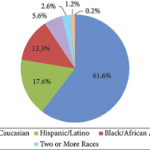Introduction:
Racial disparities in the criminal justice system have long been a pervasive issue in the United States, reflecting systemic inequalities and biases that disproportionately affect communities of color. This essay explores the causes and consequences of racial disparities in the criminal justice system, examining the impact on individuals, communities, and society at large.
Historical Context and Systemic Inequalities
Legacy of Slavery and Jim Crow:
The historical legacy of slavery and segregation has had enduring effects on the criminal justice system, contributing to entrenched racial biases, disparities in law enforcement practices, and unequal treatment under the law.
War on Drugs:
Policies such as the War on Drugs have disproportionately targeted communities of color, resulting in harsher sentencing for drug offenses and higher rates of incarceration among African American and Hispanic populations, despite similar rates of drug use across racial groups.
Policing Practices and Law Enforcement Bias
Racial Profiling:
Law enforcement practices such as racial profiling, stop-and-frisk, and pretextual traffic stops disproportionately target people of color, leading to higher rates of police encounters, arrests, and use of force incidents.
Implicit Bias:
Implicit biases held by police officers and criminal justice professionals can influence decision-making at every stage of the criminal justice process, from initial contact with law enforcement to sentencing and parole decisions, resulting in disparities in outcomes for racial and ethnic minorities.

Prosecution, Sentencing, and Incarceration
Prosecutorial Discretion:
Prosecutors wield significant discretion in charging decisions, plea bargaining, and sentencing recommendations, which can result in racial disparities in case outcomes and sentences imposed on defendants of color.
Mandatory Minimums:
Mandatory minimum sentencing laws and sentencing disparities for crack cocaine versus powder cocaine offenses have disproportionately impacted African American communities, leading to longer sentences and higher rates of incarceration for minor drug offenses.
Consequences for Individuals and Communities
Loss of Trust:
Racial disparities erode trust in the criminal justice system and perpetuate feelings of injustice and alienation among communities of color, hindering cooperation with law enforcement and undermining public safety efforts.
Inter generational Impact:
The inter generational impact of mass incarceration and criminalization of communities of color has far-reaching consequences for families and communities, including economic instability, social dislocation, and cycles of poverty and incarceration.
Calls for Reform and Solutions
Criminal Justice Reform:
Calls for criminal justice reform seek to address racial disparities through measures such as reducing mandatory minimums, investing in alternatives to incarceration, implementing implicit bias training for law enforcement, and promoting community policing initiatives.
Ending Mass Incarceration:
Ending mass incarceration requires rethinking punitive approaches to crime and investing in rehabilitation, reentry, and support services for individuals returning from incarceration, with a focus on addressing the underlying social and economic factors driving criminal behavior.

Socioeconomic Factors and Disparities
Poverty and Access to Legal Representation:
Economic disparities contribute to unequal access to legal representation, with marginalized communities often unable to afford high-quality legal defense. This results in disparities in outcomes, with individuals from wealthier backgrounds having better chances of navigating the legal system successfully.
Education and Employment Opportunities:
Limited access to quality education and employment opportunities disproportionately affects communities of color, increasing the likelihood of involvement in criminal activity as a result of economic desperation. Addressing disparities in education and employment can help reduce the pipeline to the criminal justice system.
Impact of Mandatory Minimum Sentencing
Effect on Minorities:
Mandatory minimum sentencing laws have disproportionately affected minority communities, particularly African American and Hispanic individuals. These laws have led to harsher penalties for nonviolent drug offenses, contributing to the overrepresentation of minorities in prisons and perpetuating racial disparities in sentencing.
Sentencing Reform Efforts:
Advocates for criminal justice reform have called for the repeal or reform of mandatory minimum sentencing laws to address racial disparities and promote fairer sentencing practices. Reforms may include giving judges greater discretion in sentencing and prioritizing alternatives to incarceration for nonviolent offenses.
Intersectionality and Gender Disparities
Intersectional Identities:
Intersectionality—the interconnected nature of social categorizations such as race, gender, and socioeconomic status—plays a significant role in shaping experiences within the criminal justice system. Women of color, for example, face unique challenges and disparities that intersect with both racial and gender dynamics.
Female Incarceration Rates:
While men make up the majority of the incarcerated population, the rate of female incarceration has been increasing at a faster pace. Women of color are disproportionately impacted by this trend, often facing harsher sentences and inadequate support services upon release.
Community Policing and Trust Building
Community Policing Initiatives:
Community policing approaches that prioritize building relationships between law enforcement and communities can help reduce racial disparities in policing and improve public safety outcomes. These initiatives focus on collaboration, transparency, and accountability, empowering communities to work with law enforcement to address local concerns.
Rebuilding Trust:
Rebuilding trust between law enforcement and communities of color is essential for addressing racial disparities in the criminal justice system. Efforts to increase transparency, accountability, and oversight of law enforcement practices can help restore confidence and legitimacy in the justice system.

Implicit Bias and Cultural Competency Training
Law Enforcement Training:
Providing law enforcement officers with implicit bias training and cultural competency programs can help raise awareness of unconscious biases and promote fair and equitable policing practices. These trainings should emphasize empathy, de-escalation techniques, and understanding diverse communities.
Judicial Training:
Similar training programs should be implemented for judges, prosecutors, and other legal professionals to mitigate the impact of implicit bias in decision-making processes such as bail hearings, plea bargaining, and sentencing Data Collection and Transparency
Data Collection Practices:
Improving data collection and reporting practices within the criminal justice system is essential for identifying and addressing racial disparities. Standardized data collection methods should include race and ethnicity identifiers to track disparities at every stage of the criminal justice process.
Transparency and Accountability:
Making criminal justice data publicly available and accessible allows for greater transparency and accountability. Regular reporting on racial disparities in arrests, convictions, and sentencing outcomes can help hold institutions accountable and inform policy reform efforts.
Diversion and Alternative Sentencing Programs
Pretrial Diversion:
Implementing pretrial diversion programs that offer alternatives to traditional prosecution for low-level offenses can help reduce racial disparities in the justice system. These programs may include drug treatment, mental health counseling, or community service in lieu of incarceration.
Restorative Justice:
Emphasizing restorative justice practices that focus on repairing harm, promoting healing, and reintegrating offenders into the community can address underlying issues contributing to criminal behavior while reducing reliance on punitive measures that disproportionately impact communities of color.
Conclusion
Addressing racial disparities in the criminal justice system requires a multifaceted approach that addresses systemic inequalities, biases, and injustices at every level of the justice system. By investing in training and education, promoting transparency and accountability, expanding diversion and alternative sentencing programs, empowering communities, and enacting legislative reforms, the USA can move towards a more equitable and just criminal justice system that respects the rights and dignity of all individuals, regardless of race or ethnicity.
Racial disparities in the criminal justice system are a reflection of broader systemic inequalities and biases that continue to plague American society. Addressing these disparities requires comprehensive reform efforts aimed at dismantling structural barriers, promoting fairness and equity, and fostering trust and legitimacy in the criminal justice system. By confronting the root causes of racial disparities and embracing evidence-based policies and practices, the United States can move towards a more just, equitable, and inclusive society for all.



